Configure SR-IOV network interfaces for SAP HANA on SUSE KVM
 Suggest changes
Suggest changes


Configure SR-IOV network interfaces on SUSE KVM for SAP HANA. Set up virtual functions (VFs), assign them to VMs, and configure redundant network connections for optimal performance and storage access.
Step 1: Setup SR-IOV
Enable and configure SR-IOV functionality in the adapter firmware to allow virtual function creation.
This procedure is based on NVIDIA Enterprise Support Portal | HowTo Configure SR-IOV for ConnectX-4/ConnectX-5/ConnectX-6 with KVM (Ethernet). The SUSE SAP HANA KVM guide describes this based on an INTEL NIC.
It is recommended to use redundant ethernet connections by combining two physical ports as trunk/bond. The virtual ports (VF) assigned to the VM need to be trunked as well within the VM.
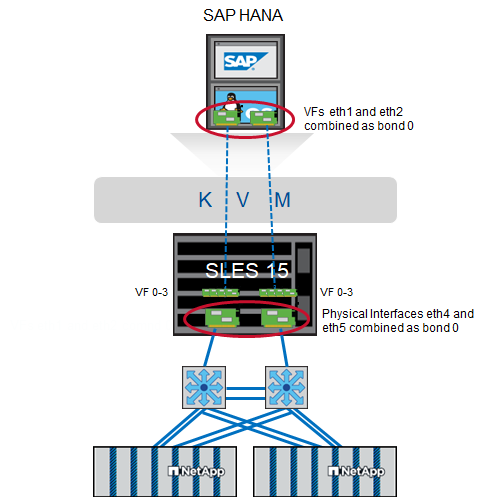
Make sure the following prerequisites are met:
-
KVM is installed
-
SR-IOV is enabled in the servers BIOS
-
PCI Passthrough is enabled by adding “intel_iommu=on” and “iommu=pt” as option at the bootloader
-
Latest MLNX_OFED drivers are installed at KVM hosts and VM.

|
Each VF assigned to a VM requires at least 10 Gbit/s bandwidth. Do not create and assign more than two VFs for a 25GbE physical port. |
-
Run MFT (Mellanox Firmware Tools):
# mst start Starting MST (Mellanox Software Tools) driver set Loading MST PCI module – Success Loading MST PCI configuration module – Success Create devices Unloading MST PCI module (unused) – Success
-
Locate the device:
# mst status MST modules: ------------ MST PCI module is not loaded MST PCI configuration module loaded MST devices: ------------ /dev/mst/mt4125_pciconf0 - PCI configuration cycles access. domain:bus:dev.fn=0000:ab:00.0 addr.reg=88 data.reg=92 cr_bar.gw_offset=-1 Chip revision is: 00
-
Check the status of the device:
mlxconfig -d /dev/mst/mt4125_pciconf0 q |grep -e SRIOV_EN -e NUM_OF_VFS NUM_OF_VFS 8 SRIOV_EN True(1)_
-
If necessary, enable SR-IOV:
mlxconfig -d /dev/mst/mt4125_pciconf0 set SRIOV_EN=1
-
Set the max amount of VFs:
mlxconfig -d /dev/mst/mt4125_pciconf0 set NUM_OF_VFS=4
-
Reboot the server if the feature needed to be enabled or the amount of max VFs has been changed.
Step 2: Create the virtual interfaces
Create virtual functions (VFs) on the physical network ports to enable SR-IOV functionality. In this step, four VFs are created per physical port.
-
Find the device:
# ibstat CA 'mlx5_0' CA type: MT4125 Number of ports: 1 Firmware version: 22.36.1010 Hardware version: 0 Node GUID: 0xa088c20300a6f6fc System image GUID: 0xa088c20300a6f6fc Port 1: State: Active Physical state: LinkUp Rate: 100 Base lid: 0 LMC: 0 SM lid: 0 Capability mask: 0x00010000 Port GUID: 0xa288c2fffea6f6fd Link layer: Ethernet CA 'mlx5_1' CA type: MT4125 Number of ports: 1 Firmware version: 22.36.1010 Hardware version: 0 Node GUID: 0xa088c20300a6f6fd System image GUID: 0xa088c20300a6f6fc Port 1: State: Active Physical state: LinkUp Rate: 100 Base lid: 0 LMC: 0 SM lid: 0 Capability mask: 0x00010000 Port GUID: 0xa288c2fffea6f6fd Link layer: Ethernet
If a bond has been created the output would look like the following:
# ibstat CA 'mlx5_bond_0' CA type: MT4125 Number of ports: 1 Firmware version: 22.36.1010 Hardware version: 0 Node GUID: 0xa088c20300a6f6fc System image GUID: 0xa088c20300a6f6fc Port 1: State: Active Physical state: LinkUp Rate: 100 Base lid: 0 LMC: 0 SM lid: 0 Capability mask: 0x00010000 Port GUID: 0xa288c2fffea6f6fc Link layer: Ethernet #:/etc/sysconfig/network # cat /sys/class/infiniband/mlx5_bond_0/device/ aerdevcorrectable iommugroup/ resetmethod aerdevfatal irq resource aerdevnonfatal link/ resource0 arienabled localcpulist resource0wc brokenparitystatus localcpus revision class maxlinkspeed rom config maxlinkwidth sriovdriversautoprobe consistentdmamaskbits mlx5_core.eth.0/ sriovnumvfs urrentlinkspeed mlx5_core.rdma.0/ sriovoffset currentlinkwidth modalias sriovstride d3coldallowed msibus sriovtotalvfs device msiirqs/ sriovvfdevice dmamaskbits net/ sriovvftotalmsix driver/ numanode subsystem/ driveroverride pools subsystemdevice enable power/ subsystemvendor firmwarenode/ powerstate uevent infiniband/ ptp/ vendor infinibandmad/ remove vpd infinibandverbs/ rescan iommu/ reset
# ibdev2netdev mlx5_0 port 1 ==> eth4 (Up) mlx5_1 port 1 ==> eth5 (Up)
-
Get the total VFs that are allowed and configured in the firmware:
# cat /sys/class/net/eth4/device/sriov_totalvfs 4 # cat /sys/class/net/eth5/device/sriov_totalvfs 4
-
Get the current number of VFs on this device:
# cat /sys/class/infiniband/mlx5_0/device/sriov_numvfs 0 # cat /sys/class/infiniband/mlx5_1/device/sriov_numvfs 0
-
Set the desired number of VFs:
# echo 4 > /sys/class/infiniband/mlx5_0/device/sriov_numvfs # echo 4 > /sys/class/infiniband/mlx5_1/device/sriov_numvfs
If you already configured a bond using these two ports the first command needs to be executed against the bond:
# echo 4 > /sys/class/infiniband/mlx5_bond_0/device/sriov_numvfs
-
Check the PCI bus:
# lspci -D | grep Mellanox 0000:ab:00.0 Ethernet controller: Mellanox Technologies MT2892 Family [ConnectX-6 Dx] 0000:ab:00.1 Ethernet controller: Mellanox Technologies MT2892 Family [ConnectX-6 Dx] 0000:ab:00.2 Ethernet controller: Mellanox Technologies ConnectX Family mlx5Gen Virtual Function 0000:ab:00.3 Ethernet controller: Mellanox Technologies ConnectX Family mlx5Gen Virtual Function 0000:ab:00.4 Ethernet controller: Mellanox Technologies ConnectX Family mlx5Gen Virtual Function 0000:ab:00.5 Ethernet controller: Mellanox Technologies ConnectX Family mlx5Gen Virtual Function 0000:ab:01.2 Ethernet controller: Mellanox Technologies ConnectX Family mlx5Gen Virtual Function 0000:ab:01.3 Ethernet controller: Mellanox Technologies ConnectX Family mlx5Gen Virtual Function 0000:ab:01.4 Ethernet controller: Mellanox Technologies ConnectX Family mlx5Gen Virtual Function 0000:ab:01.5 Ethernet controller: Mellanox Technologies ConnectX Family mlx5Gen Virtual Function
# ibdev2netdev -v 0000:ab:00.0 mlx5_0 (MT4125 - 51TF3A5000XV3) Mellanox ConnectX-6 Dx 100GbE QSFP56 2-port PCIe 4 Ethernet Adapter fw 22.36.1010 port 1 (ACTIVE) ==> eth4 (Up) 0000:ab:00.1 mlx5_1 (MT4125 - 51TF3A5000XV3) Mellanox ConnectX-6 Dx 100GbE QSFP56 2-port PCIe 4 Ethernet Adapter fw 22.36.1010 port 1 (ACTIVE) ==> eth6 (Up) 0000:ab:00.2 mlx523 (MT4126 - NA) fw 22.36.1010 port 1 (DOWN ) ==> eth6 (Down) 0000:ab:00.3 mlx5_3 (MT4126 - NA) fw 22.36.1010 port 1 (DOWN ) ==> eth7 (Down) 0000:ab:00.4 mlx5_4 (MT4126 - NA) fw 22.36.1010 port 1 (DOWN ) ==> eth8 (Down) 0000:ab:00.5 mlx5_5 (MT4126 - NA) fw 22.36.1010 port 1 (DOWN ) ==> eth9 (Down) 0000:ab:01.2 mlx5_6 (MT4126 - NA) fw 22.36.1010 port 1 (DOWN ) ==> eth10 (Down) 0000:ab:01.3 mlx5_7 (MT4126 - NA) fw 22.36.1010 port 1 (DOWN ) ==> eth11 (Down) 0000:ab:01.4 mlx5_8 (MT4126 - NA) fw 22.36.1010 port 1 (DOWN ) ==> eth12 (Down) 0000:ab:01.5 mlx5_9 (MT4126 - NA) fw 22.36.1010 port 1 (DOWN ) ==> eth13 (Down)
-
Check the VFs configuration via the IP tool:
# ip link show … 6: eth4: <BROADCAST,MULTICAST,SLAVE,UP,LOWER_UP> mtu 9000 qdisc mq master bond0 state UP mode DEFAULT group default qlen 1000 link/ether a0:88:c2:a6:f6:fd brd ff:ff:ff:ff:ff:ff permaddr a0:88:c2:a6:f6:fc vf 0 link/ether 00:00:00:00:00:00 brd ff:ff:ff:ff:ff:ff, spoof checking off, link-state auto, trust off, query_rss off vf 1 link/ether 00:00:00:00:00:00 brd ff:ff:ff:ff:ff:ff, spoof checking off, link-state auto, trust off, query_rss off vf 2 link/ether 00:00:00:00:00:00 brd ff:ff:ff:ff:ff:ff, spoof checking off, link-state auto, trust off, query_rss off vf 3 link/ether 00:00:00:00:00:00 brd ff:ff:ff:ff:ff:ff, spoof checking off, link-state auto, trust off, query_rss off altname enp171s0f0np0 altname ens3f0np0 7: eth5: <BROADCAST,MULTICAST,SLAVE,UP,LOWER_UP> mtu 9000 qdisc mq master bond0 state UP mode DEFAULT group default qlen 1000 link/ether a0:88:c2:a6:f6:fd brd ff:ff:ff:ff:ff:ff vf 0 link/ether 00:00:00:00:00:00 brd ff:ff:ff:ff:ff:ff, spoof checking off, link-state auto, trust off, query_rss off vf 1 link/ether 00:00:00:00:00:00 brd ff:ff:ff:ff:ff:ff, spoof checking off, link-state auto, trust off, query_rss off vf 2 link/ether 00:00:00:00:00:00 brd ff:ff:ff:ff:ff:ff, spoof checking off, link-state auto, trust off, query_rss off vf 3 link/ether 00:00:00:00:00:00 brd ff:ff:ff:ff:ff:ff, spoof checking off, link-state auto, trust off, query_rss off altname enp171s0f1np1 altname ens3f1np1 …
Step 3: Enable VFs during boot
Configure the VF settings to persist across system reboots by creating systemd services and startup scripts.
-
Create a systemd unit file
/etc/systemd/system/after.localwith the following content:[Unit] Description=/etc/init.d/after.local Compatibility After=libvirtd.service Requires=libvirtd.service [Service] Type=oneshot ExecStart=/etc/init.d/after.local RemainAfterExit=true [Install] WantedBy=multi-user.target
-
Create the script /etc/init.d/after.local:
#! /bin/sh # # # ... echo 4 > /sys/class/infiniband/mlx5_bond_0/device/sriov_numvfs echo 4 > /sys/class/infiniband/mlx5_1/device/sriov_numvfs
-
Ensure that the file can be executed:
# cd /etc/init.d/ # chmod 750 after.local
Step 4: Assign the virtual interfaces to the VM
Assign the created virtual functions to the SAP HANA VM as PCI host devices using virt-manager
-
Start virt-manager.

-
Open the desired VM.
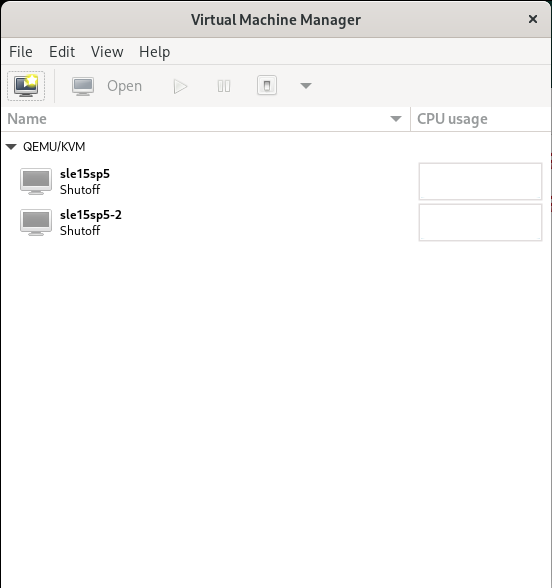
-
Select Add Hardware.
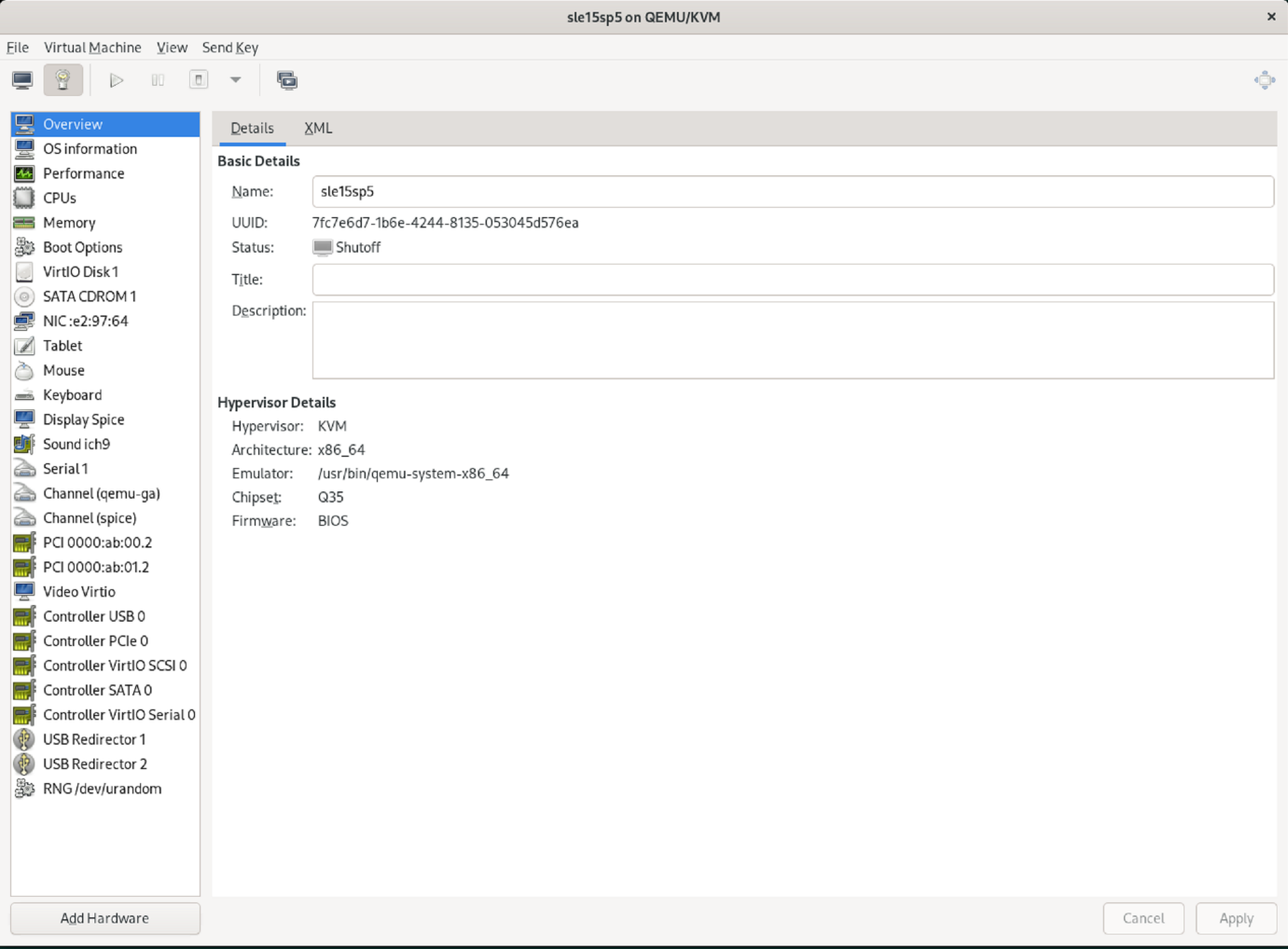
-
Choose the desired virtual NIC from the first physical port from the list of PCI Host Device and press finish.
In this example 0000.AB:00:2 - 0000.AB:00:4 belong to the first physical port and 0000.AB:01:2 - 0000.AB:01:4 belong to the second physical port.

-
Choose the next virtual NIC port from the list of PCI Host Device, use a virtual port from the second physical port and select Finish.

-
Afterwards the virtual interfaces are assigned to the VM and the VM can be started.
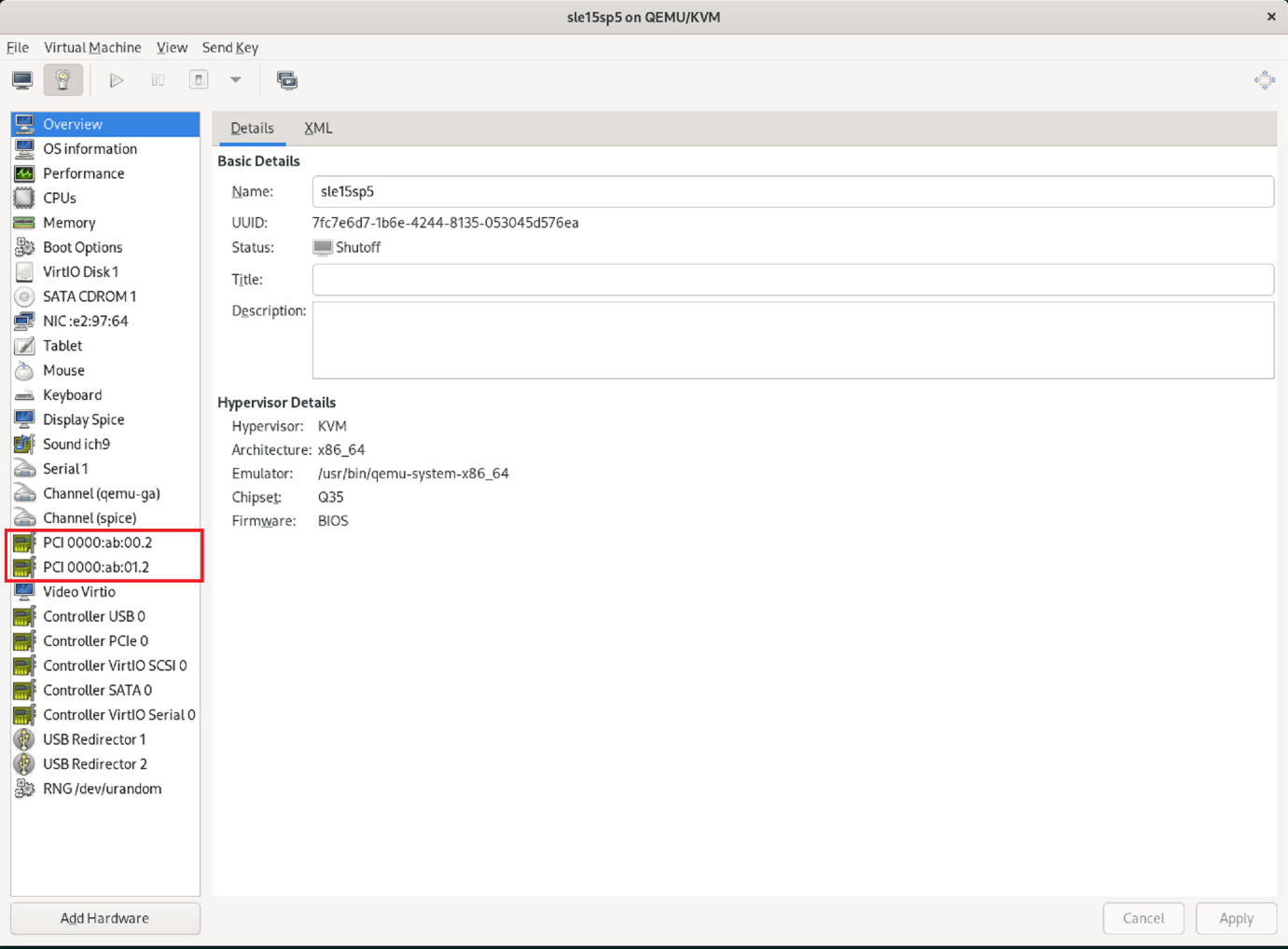
Step 5: Configure network interfaces within the VM
Log in to the VM and configure the two VFs as bond. Choose either mode 0 or mode 2. Do not use LACP as LACP can only be used on physical ports. The figure below shows a mode 2 configuration using YAST.
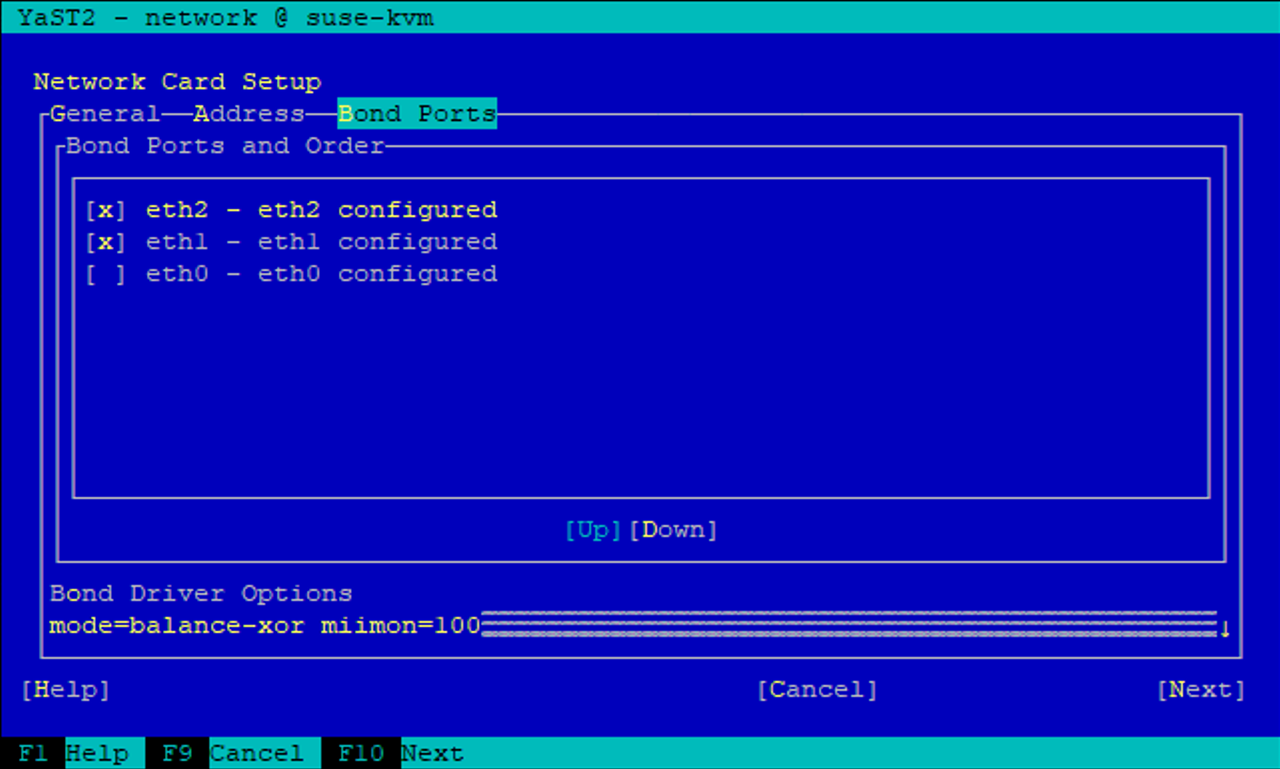
What's next?
After you've configured SR-IOV network interfaces, configure Fibre Channel networking if FCP shall be used as storage protocoll.


